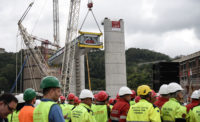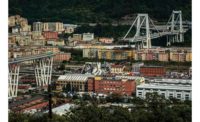Years of working on prominent, fast-track projects in Africa equipped Italian engineer Claudio Lautizi to manage the speedy replacement of Genoa’s 1.1-km-long collapsed Polcevera viaduct in full public glare. The last of 19 spans of the new San Giorgio bridge went up in April 2020, just a year after construction workers began moving onto the site.
When two spans of the decades-old concrete viaduct collapsed in the Italian coastal city in August 2018, causing 43 deaths, “we immediately understood that [the reconstruction] was not a project for the country, this was a project for the world,” says Lautizi.
Lautizi speedily assembled a top team to bid and mobilize for the reconstruction, which had become a government priority. With experience on major projects in developing countries, he was prepared for the pressure of succeeding with what had become the world’s most prominent bridge.
The 60-year-old Rome-born engineer had recently become general manager for international and home operations of Italy’s largest contractor, Webuild S.p.A. Since joining the company in 1988, he had risen through the ranks working internationally on fast-track megaprojects.
Having never actually worked in Italy until months before the collapse, Lautizi says he knew little about local construction conditions except “how bureaucratic it was.” But to build the new 1,067-meter-long steel box bridge, the government broke with tradition. It charged Genoa’s mayor, Marco Bucci, with the reconstruction, giving him “totally unusual” powers, says Lautizi. Bucci “was an excellent client.”
Local knowledge helped the contractor meet a tight, 10-day bid deadline and assemble key site staff. “We already had one of our best teams” in town, working on the roughly $8.4-billion Genoa-Milan high-speed railroad, says Lautizi.
Lautizi partnered with the infrastructure unit of state-owned Fincantieri S.p.A. to form the 50/50 PerGenova joint venture, led by Webuild’s Nicola Meistro, who had been general manager of the high-speed railroad. That project also released Francesco Poma to become the viaduct’s project director. Locally based architect Renzo Piano provided an outline scheme free of charge while Italferr S.p.A. handled detailed design.
PerGenova offered to design and build the new bridge for around $245 million in 12 months from gaining site access, while taking no profit. It won the contract in late 2018.
“The construction was very fast because we worked 24 hours a day, seven days a week,” says Lautizi, praising the workforce. Even as the pandemic ripped though northern Italy, except for Christmas Day “the Genoa bridge never stopped; not one single day,” he says.
Poma also praises Genoa’s bridge team. “Everybody who worked on this gave it their all,” he says. Meistro adds that “tireless” efforts by the workers revealed “a strength which comes from the spirit of collaboration.”
_enrready.jpg?t=1611166905&width=1080)






Post a comment to this article
Report Abusive Comment